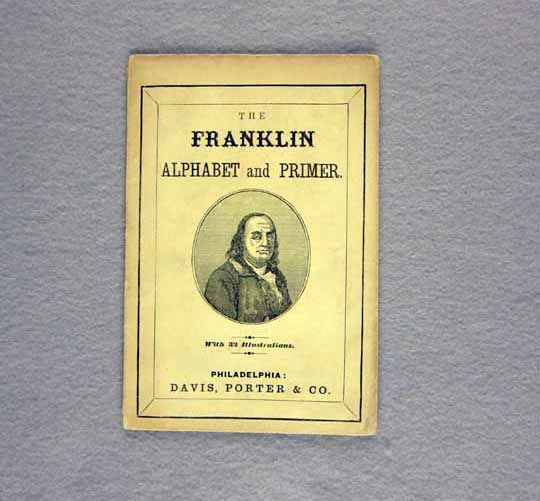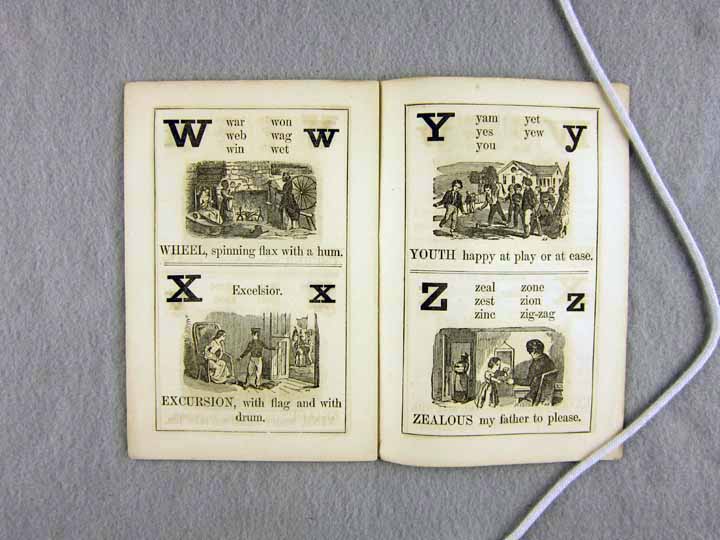

Alphabet books offer a vivid insight into the history of literacy and culture, as well as concepts of childhood. The Children's Book Collection at UCLA contains a rich array of these materials, some well-worn and much-used, some still bright and fresh. Each is a gem of print production and graphical imagery from another time and place. Though the history of alphabet books continues to the present, this exhibit focuses on the works in our collections published between 1700 and 1900, including horn books, primers, works of didacticism and seriousness, whimsy and play.
2. A Jumble ABC
3. A Little Pretty Pocket-Book
4. A New Lottery Book of Birds And Beasts
5. A Pretty Play-Thing for Children of All Denominations
8. ABC of Objects for Home And School
10. ABC with Pictures & Verses
12. Alphabet Et Instruction Pour Les Enfans
16. Dolly's ABC Book
17. Flora's ABC
18. Home ABC
22. Hornbook C. 1700
23. Large Letters for the Little Ones
24. Little ABC Book
25. Little People: An Alphabet
26. Martin's Nursery Battledoor
27. Mother Goose ABC
28. My Darling's ABC
29. Orbis Sensualium Pictus Quadrilinguis
30. People of All Nations: A Useful Toy for Girl Or Boy
31. Picture Alphabet
32. Pretty ABC
33. Railway ABC
34. Rusher's Reading Made Most Easy
38. The Alphabet of Old Friends
40. The Amusing Alphabet for Young Children Beginning To Read
42. The Child's Christian Education
45. The Easter Gift
47. The Favorite Alphabet for the Nursery
49. The Franklin Alphabet And Primer
51. The Golden ABC
55. The Moral And Entertaining Alphabet
57. The Old Testament Alphabet
59. The Picture Alphabet for Little Children
62. The Sunday ABC
63. The Union ABC
64. The Young Child's ABC, Or, First Book
65. Tom Thumb's Alphabet: Picture Baby-Books
67. Warne's Alphabet And Word Book: with Coloured Pictures
68. Wood's Royal Nursery Alphabet
Title The Franklin Alphabet And Primer



Brief description This is an American chapbook with 32 illustrations done with woodblocks.
Full description This primer provides the alphabet illustrated with woodblock prints along with a progression to monosyllabic words and small sentences. The scenes in the woodblock prints depict the domestic life of an American middle class family living in the countryside, focusing on the children in their day to day activities of school attendance and household chores. Printed by an up and coming Philadelphia publisher of the mid to late nineteenth century, it is made of inexpensive materials for a broadened audience.
Literacy The alphabet is put forth in both upper and lower cases accompanied by a monosyllabic word and woodblock picture depicting the word. Although the scenes represent domestic life and relationships, the corresponding letter and word have a direct relationship allowing the child to identify the sounds from the word with the letter. The picture also comes with a sentence firmly associating that object within the actions of the everyday allowing for further association. This primer provides for gradual learning beginning with the alphabet and then progressing to lists of smaller mono or duosyllabic words and then gradually forming sentences. This culminates in three woodcut scenes with a fuller descriptive paragraph accompanying them, allowing for the child to match the visual representation to the alphabetic abstraction.
Childhood The children depicted are firmly entrenched in family life, often seen helping with household chores or assisting their parents with the younger children. Childhood, especially childhood for girls here is mostly productive, learning in school, mending and knitting. They are continually eager to please and subdued, "Z is for zealous my father to please." The children of this family however are rarely performing manual labor and are still seen as participants in the domestic sphere rather than that of commerce or farm work. The woodblocks create the sense of stasis, even in the rare moment of play "Y is for Youth happy at play or at ease," the boys seem suspended and contained, well dressed, there is no intimation of unruliness. Emotions are frivolous, "A is for Annie who foolishly cries." Even the infant only peeps.
Iconography Because most of the woodcuts depict scenes of domestic life as opposed to individual people, animals or objects, relationships and dynamics are exposed. The family is fairly affluent, predominantly pictured in states of relaxation and leisure; there is a formality to the quality of dress and posture that also suggests this. The father is always seen reading, literacy is an integral part of his position in the world. This family resides in the country, the only architecture seen is the interior of their home and the church in the distance, an idyllic setting allowing for leisurely play and family relationships. All of these scenes are firmly placed within an American context, through the relationships and images presented. One panel shows "R is for the red man trading the lands of his birth." The men and women in this picture are passively exchanging beads and ostensibly land for blankets from European settlers. The Native Americans are all wearing feather headdresses and are calmly engaged in this moment of exchange. The sentence accompanying the picture belies certain judgments but the scene is relatively subdued.
Production This was published by a prominent Philadelphia publisher in 1865. At the time they were operating as Davis, Porter and Co. (1865-1866) and had been preceded by their previous incarnation Davis and Porter (1848-1865). They later became Davis, Porter and Coates (1866-1867) and then ultimately Porter and Coates (1867-1895). As this publishing company rose to prominence alongside a diversified and growing children's market, they became to be known for reprint series and well made adventure stories, publishing the likes of Jules Verne and Horatio Alger. This primer was earlier in the publisher's history and is made in the chapbook style, meant to be cheaply obtained and distributed.
Publisher Davis, Porter & Co.
Publication place Philadelphia
Date 1865
UCLA Call Number CBC PE1119.A1 F73 1865
Repository UCLA Charles E. Young Research Library, Dept. of Special Collections
Dimensions 17 cm
Additional Information Inscription: Ex libris Elvah Karshner.
Caption